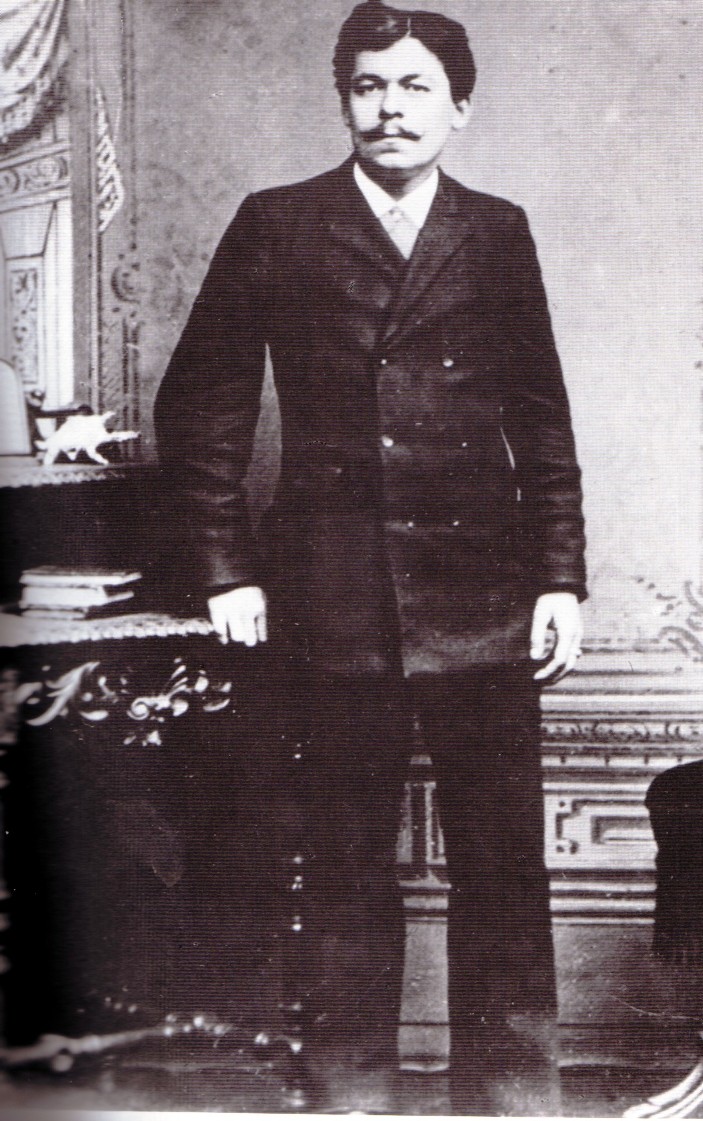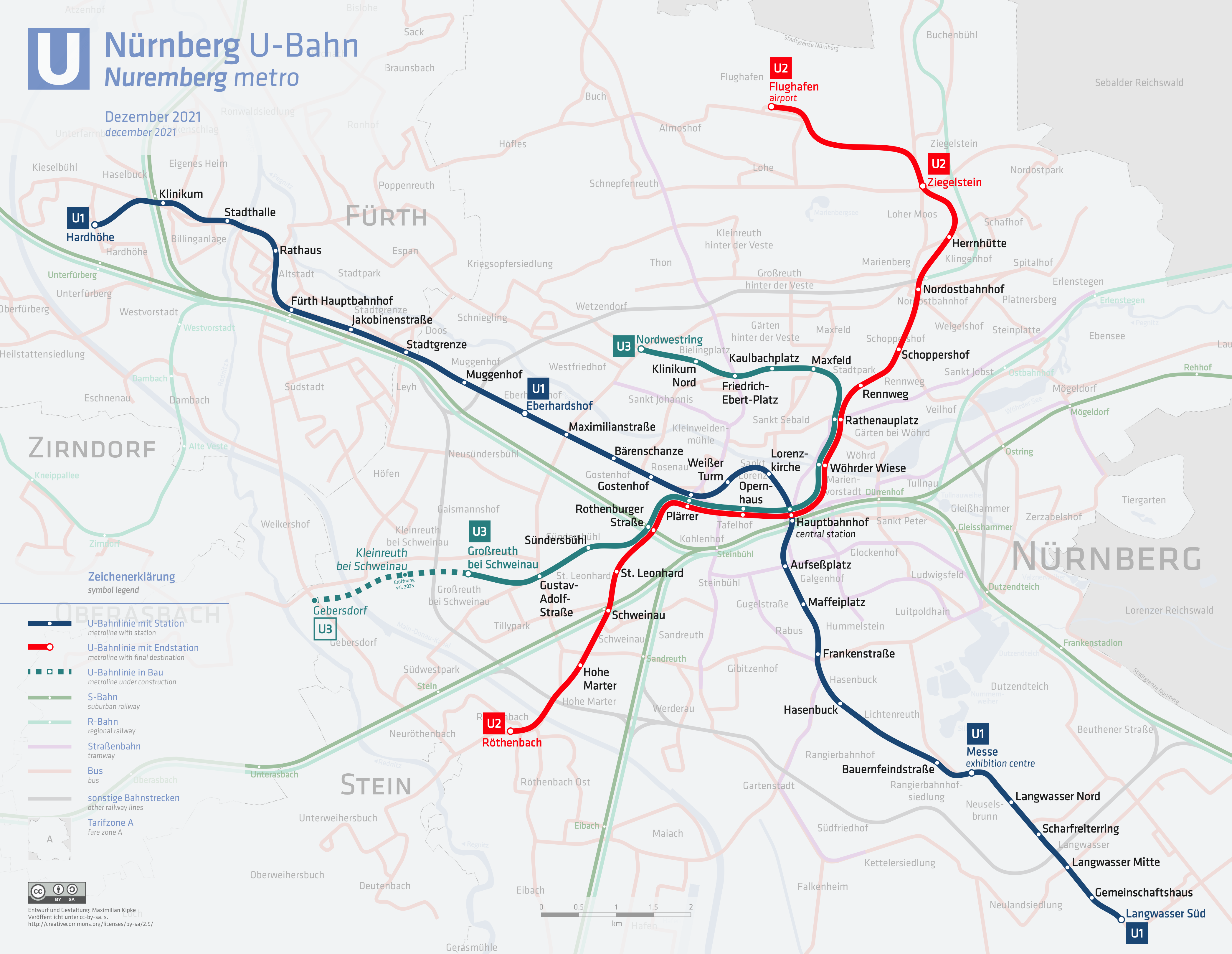|
Friedrich Ebert Platz (Nuremberg U-Bahn)
Friedrich-Ebert-Platz station is a Nuremberg U-Bahn station. It was the northern terminus of the U3 line from its opening on 10 December 2011 until 2017, when the extension towards Nordwestring opened. It offers interchange to Tramway line 4. Like Aufseßplatz, Hauptbahnhof and Plärrer orange tiles were used in the walls of this station to indicate a possible future interchange station. However, as of 2021 no such interchange to another subway line is planned for the foreseeable future. Name The station is named after the square beneath which it lies, which is in turn named after Germany's first Reichspräsident, the SPD politician Friedrich Ebert. Rathenauplatz station is another important Nuremberg U-Bahn station named (indirectly) after a Weimar Republic The Weimar Republic (german: link=no, Weimarer Republik ), officially named the German Reich, was the government of Germany from 1918 to 1933, during which it was a constitutional federal republic for the first tim ... [...More Info...] [...Related Items...] OR: [Wikipedia] [Google] [Baidu] |
Nordwestring (Nuremberg U-Bahn)
Nordwestring station is a Nuremberg U-Bahn station. It is the northern terminus of the U3 line and was opened on 22 May 2017. Location The station is located on the border of the Nuremberg districts ''Bielingplatz'' and ''Wetzendorf'' and extends underground in east-west orientation across the ''Nordwestring'' (part of B4R) between ''Bielefelder Straße'' and ''Heimerichstraße''. The building is located in a simple depth (7.70 m) below the earth's surface. At each platform end there is an elevator, as well as stairs and escalators, which are a direct link to the surface. Behind the underground station, under ''Bielefelder Straße'', there is a 170 m long, double-track tunnel A tunnel is an underground passageway, dug through surrounding soil, earth or rock, and enclosed except for the entrance and exit, commonly at each end. A pipeline is not a tunnel, though some recent tunnels have used immersed tube cons ..., which is used as a parking or turning facility. [...More Info...] [...Related Items...] OR: [Wikipedia] [Google] [Baidu] |
Weimar Republic
The Weimar Republic (german: link=no, Weimarer Republik ), officially named the German Reich, was the government of Germany from 1918 to 1933, during which it was a constitutional federal republic for the first time in history; hence it is also referred to, and unofficially proclaimed itself, as the German Republic (german: Deutsche Republik, link=no, label=none). The state's informal name is derived from the city of Weimar, which hosted the constituent assembly that established its government. In English, the republic was usually simply called "Germany", with "Weimar Republic" (a term introduced by Adolf Hitler in 1929) not commonly used until the 1930s. Following the devastation of the First World War (1914–1918), Germany was exhausted and sued for peace in desperate circumstances. Awareness of imminent defeat sparked a revolution, the abdication of Kaiser Wilhelm II, formal surrender to the Allies, and the proclamation of the Weimar Republic on 9 November 1918. In its i ... [...More Info...] [...Related Items...] OR: [Wikipedia] [Google] [Baidu] |
Rathenauplatz Station
Rathenauplatz station is a Nuremberg U-Bahn station, located on the U2 and U3. The station is named for the nearby square which was in turn named for the assassinated industrial leader and foreign minister of Germany Walter Rathenau. A portrait of Rathenau adorns the walls of the station and there is also a portrait of the father of Zionism, Theodor Herzl. When traveling in a northerly direction, Rathenauplatz is the last station served by both U2 and U3 and it is therefore a busy interchange station. Late night U3 trips short turn here from Großreuth bei Schweinau station Großreuth bei Schweinau station is a Nuremberg U-Bahn station, located on the U3. Named for the borough Großreuth bei Schweinau. The distance to the previous station, Gustav Adolf Straße is as the crow flies __NOTOC__ The expression ''a .... References Nuremberg U-Bahn stations Railway stations in Germany opened in 1990 Buildings and structures completed in 1990 Walther Rathenau {{Nuremb ... [...More Info...] [...Related Items...] OR: [Wikipedia] [Google] [Baidu] |
Friedrich Ebert
Friedrich Ebert (; 4 February 187128 February 1925) was a German politician of the Social Democratic Party of Germany (SPD) and the first President of Germany (1919–1945), president of Germany from 1919 until his death in office in 1925. Ebert was elected leader of the SPD on the death in 1913 of August Bebel. In 1914, shortly after he assumed leadership, the party became deeply divided over Ebert's support of war loans to finance the German war effort in World War I. A moderate social democrat, Ebert was in favour of the ''Burgfriedenspolitik, Burgfrieden'', a political policy that sought to suppress squabbles over domestic issues among political parties during wartime in order to concentrate all forces in society on the successful conclusion of the war effort. He tried to isolate those in the party opposed to the war and advocated a split. Ebert was a pivotal figure in the German Revolution of 1918–19. When Germany became a republic at the end of World War I, he became its ... [...More Info...] [...Related Items...] OR: [Wikipedia] [Google] [Baidu] |
Social Democratic Party Of Germany
The Social Democratic Party of Germany (german: Sozialdemokratische Partei Deutschlands, ; SPD, ) is a centre-left social democratic political party in Germany. It is one of the major parties of contemporary Germany. Saskia Esken has been the party's leader since the 2019 leadership election together with Lars Klingbeil, who joined her in December 2021. After Olaf Scholz was elected chancellor in 2021 the SPD became the leading party of the federal government, which the SPD formed with the Greens and the Free Democratic Party, after the 2021 federal election. The SPD is a member of 11 of the 16 German state governments and is a leading partner in seven of them. The SPD was established in 1863. It was one of the earliest Marxist-influenced parties in the world. From the 1890s through the early 20th century, the SPD was Europe's largest Marxist party, and the most popular political party in Germany. During the First World War, the party split between a pro-war mainstream ... [...More Info...] [...Related Items...] OR: [Wikipedia] [Google] [Baidu] |
Hauptbahnhof (Nuremberg U-Bahn)
Central stations or central railway stations emerged in the second half of the nineteenth century as railway stations that had initially been built on the edge of city centres were enveloped by urban expansion and became an integral part of the city centres themselves.Kellerman, Aharon. "Central railway stations" in ''Daily Spatial Mobilities: Physical and Virtual'', Oxford: Routledge, 2012. pp. 159-161. Bán, D. ''The railway station in the social science.'' The Journal of Transport History, 28, 289-93, 2007. As a result, "Central Station" is often, but not always, part of the proper name for a railway station that is the central or primary railway hub for a city. Development Emergence and growth Central stations emerged in the second half of the nineteenth century during what has been termed the "Railway Age".Richards, Jeffrey and John M. MacKenzie, ''The Railway Station'', Oxford: OUP, 1986. Initially railway stations were built on the edge of city centres but, subsequent ... [...More Info...] [...Related Items...] OR: [Wikipedia] [Google] [Baidu] |
Nuremberg U-Bahn
The Nuremberg U-Bahn is a rapid transit system run by ''Verkehrs-Aktiengesellschaft Nürnberg'' (VAG; Nuremberg Transport Corporation), which itself is a member of the ''Verkehrsverbund Großraum Nürnberg'' (VGN; Greater Nuremberg Transport Network). The Nuremberg U-Bahn is Germany's newest metro system, having begun operation in 1972, although the Nuremberg-Fürth route (U1) uses part of the right of way of the Bavarian Ludwig Railway, Germany's first passenger railway opened in 1835. The current network of the U-Bahn is composed of three lines, serving 49 stations, and comprising of operational route, making it the shortest of the four metro systems in Germany, behind Berlin, Hamburg and Munich. In 2008, driverless and fully automated trains were introduced on the new U3 line, making it Germany's first automatic U-Bahn line. History Plans for a metro in Nuremberg go back to 1925, when Nuremberg graduate engineer Oscar Freytag spoke out in favor of building a metro under F� ... [...More Info...] [...Related Items...] OR: [Wikipedia] [Google] [Baidu] |
Nürnberg
Nuremberg ( ; german: link=no, Nürnberg ; in the local East Franconian dialect: ''Nämberch'' ) is the second-largest city of the German state of Bavaria after its capital Munich, and its 518,370 (2019) inhabitants make it the 14th-largest city in Germany. On the Pegnitz River (from its confluence with the Rednitz in Fürth onwards: Regnitz, a tributary of the River Main) and the Rhine–Main–Danube Canal, it lies in the Bavarian administrative region of Middle Franconia, and is the largest city and the unofficial capital of Franconia. Nuremberg forms with the neighbouring cities of Fürth, Erlangen and Schwabach a continuous conurbation with a total population of 800,376 (2019), which is the heart of the urban area region with around 1.4 million inhabitants, while the larger Nuremberg Metropolitan Region has approximately 3.6 million inhabitants. The city lies about north of Munich. It is the largest city in the East Franconian dialect area (colloquially: "Franconian"; ... [...More Info...] [...Related Items...] OR: [Wikipedia] [Google] [Baidu] |



